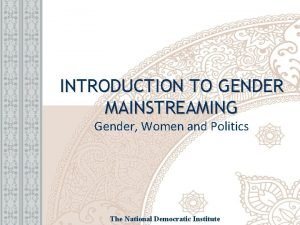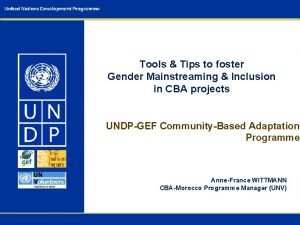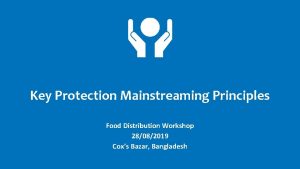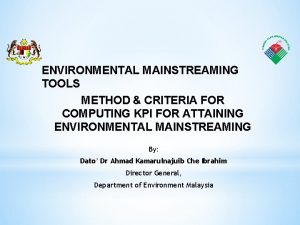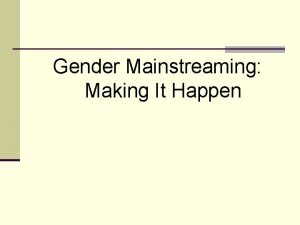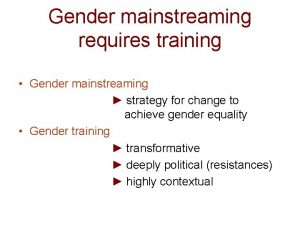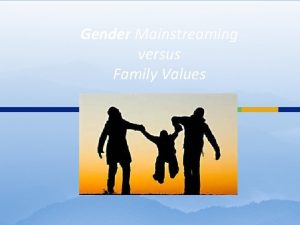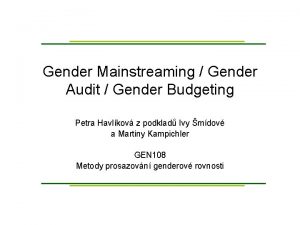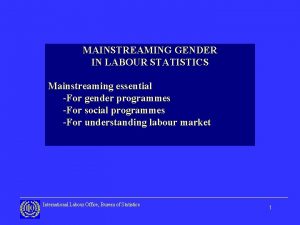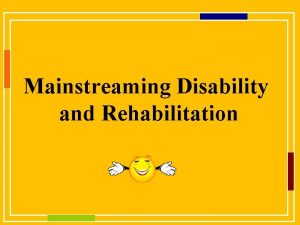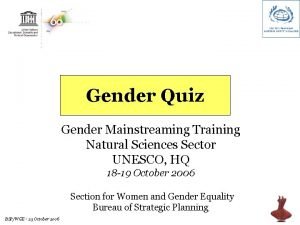Gender Mainstreaming Making It Happen Why are we













- Slides: 13

Gender Mainstreaming: Making It Happen

Why are we concerned with gender equality? n Made progress on women’s capabilities— education and health n By 2004, two thirds of 181 countries achieved gender parity in primary school enrollment n Since 1970, average life expectancy for women increased by between 15 and 20 years in developing countries

Why are we concerned with gender equality? Much less progress on women’s access to economic opportunities n In low-income countries, women’s employment rate shrank from 53% in 1980 to 49% in 2005, while men’s employment rate remained steady at 86%. n In all developing countries, women still earn on average about 22% less than men after taking into account differences in observed skills.

Why are we concerned with gender equality? n Development more effective by integrating gender issues and concerns n Engaging women as agents of change benefits women and promotes development n It is both just and fair

What is gender mainstreaming? Gender mainstreaming (GM) adopted at the Beijing Conference 1995 GM encompasses all aspects of planning, implementing and monitoring any social, political, or economic action.

What is gender mainstreaming? Commonly used definition (UN ECOSOC 1997): “Mainstreaming…. . is the process of assessing the implications for women and men of any planned action, including legislation, policies, or programmes, in all areas and at all levels……The ultimate goal is to achieve gender equality. ”

Gender mainstreaming in practice n Common understanding of the term is that involves changes in both: “internal” organizational processes and n “external” operational procedures n n Focus in the first decade mainly on internal processes—less on operations

An alternate approach in gender mainstreaming n Pragmatic, entrepreneurial, results-based n Strategic, selective and relevant n Focuses on operations & programs n Aims at obtaining results on the ground—what can be done to meet needs of low-income people

An alternate approach in gender mainstreaming n Strategic actions n focused; on relevant and potential high-impact issues n driven, not by process of mainstreaming, but by the operational issue/problem and need to find solutions for it

An alternate approach in gender mainstreaming Strategic actions n focused on relevant and potential high-impact issues n driven, not by process of mainstreaming, but by the operational issue/problem and need to find solutions for it

An alternate approach in gender mainstreaming Requires gender expertise to: n determine course of action to address the selected operational issue; n offer expert issue and/or sector-specific gender recommendations n provide “hands-on” technical assistance n design M&E systems to identify problems; trouble-shoot mid-stream, document impacts and results

An alternate approach in gender mainstreaming Also requires: n accountability for results/impacts; M&E; process and outcome indicators; n leadership—will, commitment and openness to innovation

Conclusion Alternate approach different in focus: n On operations/outcomes n Selective about development issues/problems n Generates tailored gender responses n On development effectiveness—making a difference in the lives of low-income women and men
 What is gender mainstreaming?
What is gender mainstreaming? What is gender mainstreaming?
What is gender mainstreaming? Sex videao
Sex videao Gender mainstreaming
Gender mainstreaming Antigentest åre
Antigentest åre The order in which things happen or should happen
The order in which things happen or should happen Protection mainstreaming principles
Protection mainstreaming principles Ercmc organization chart
Ercmc organization chart Mainstreaming in swahili
Mainstreaming in swahili Why why why why
Why why why why Strategic gender needs and practical gender needs
Strategic gender needs and practical gender needs College making it happen
College making it happen Pypyi
Pypyi Making homes happen 4 you
Making homes happen 4 you
